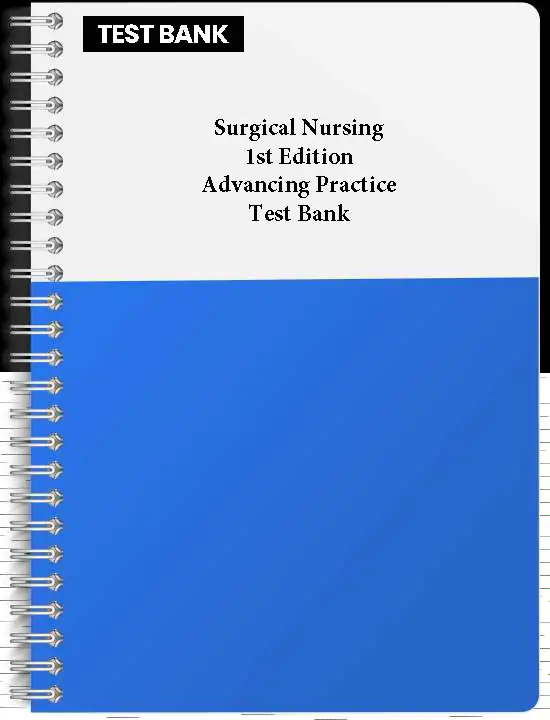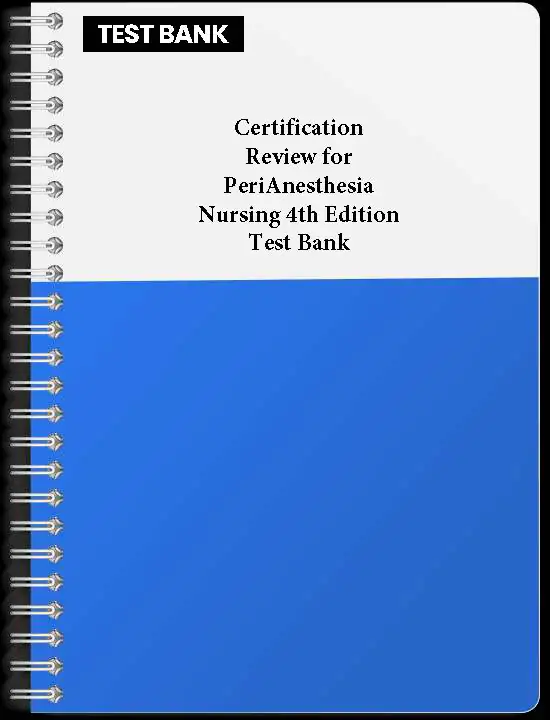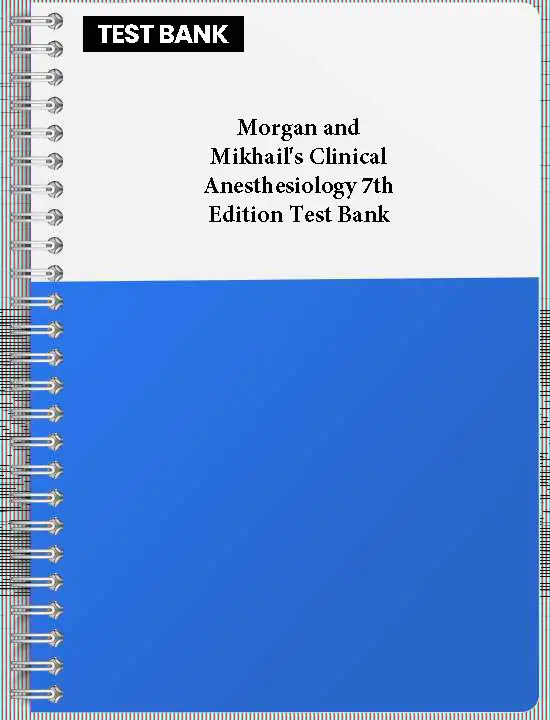Description
Miller’s Anesthesia 10th Edition Test Bank is a comprehensive tool designed to support anesthesia students and professionals in mastering the complex concepts and practices of modern anesthesiology. This test bank accompanies the foundational textbook, covering all essential areas of anesthetic practice, from basic principles to specialized techniques and patient safety. Here’s an overview of the main areas covered:
- Foundations of Anesthesia: Questions on the core principles of anesthesia, including pharmacokinetics, pharmacodynamics, mechanisms of anesthetic agents, and monitoring techniques, with a focus on safe and effective drug administration.
- Airway Management: Detailed questions on airway assessment, intubation techniques, and airway management tools. This section emphasizes recognizing and managing difficult airways and implementing techniques for both adult and pediatric patients.
- Cardiovascular and Respiratory Physiology: Covers the physiological effects of anesthesia on cardiovascular and respiratory systems, including managing patients with preexisting conditions, hemodynamic monitoring, and strategies for ventilatory support during surgery.
- Neuroanesthesia: Focuses on anesthesia considerations for neurosurgical procedures, including monitoring cerebral function, managing intracranial pressure, and optimizing anesthesia in patients with neurological disorders.
- Obstetric Anesthesia: Includes questions on anesthesia management in obstetric patients, covering pain relief techniques, complications like preeclampsia, and considerations for labor, delivery, and cesarean sections.
- Pediatric Anesthesia: Emphasizes age-specific anesthesia protocols, including pharmacology, dosing, and techniques for managing infants, children, and adolescents in the perioperative setting.
- Regional Anesthesia and Pain Management: Questions on regional anesthesia techniques such as spinal, epidural, and peripheral nerve blocks, as well as strategies for postoperative pain management and chronic pain interventions.
1 The Scope of Modern Anesthetic Practice
2 Anesthesia and Global Health Equity
3 Perioperative Medicine
4 Informatics in Perioperative Medicine
5 Quality Improvement in Anesthesia Practice and Patient Safety
6 Human Behavior and Simulation in Anesthesia
7 Ethical Aspects of Anesthesia Care
8 Consciousness, Memory, and Anesthesia
9 Sleep Medicine
10 Cerebral Physiology and the Effects of Anesthetic Drugs
11 Neuromuscular Physiology and Pharmacology
12 Respiratory Physiology and Pathophysiology
13 Cardiac Physiology
14 Gastrointestinal and Hepatic Physiology, Pathophysiology, and Anesthetic Considerations
15 Renal Anatomy, Physiology, Pharmacology, and Evaluation of Function
16 Basic Principles of Pharmacology
17 Inhaled Anesthetics: Mechanisms of Action
18 Inhaled Anesthetic Uptake, Distribution, Metabolism, and Toxicity
19 Pulmonary Pharmacology of Inhaled Anesthetics
20 Inhaled Anesthetic Delivery Systems
21 Intravenous Anesthetics
22 Opioids
23 Intravenous Drug Delivery Systems
24 Pharmacology of Neuromuscular Blocking Drugs and Antagonists (Reversal Agents)
25 Local Anesthetics
26 Immune Implications of Anesthesia Care and Practice
27 Risk of Anesthesia
28 Preoperative Evaluation
29 Anesthetic Implications of Concurrent Diseases
30 Patient Positioning and Associated Risks
31 Neuromuscular Disorders and Other Genetic Disorders
32 Cardiovascular Monitoring
33 Perioperative Echocardiography and Point-of-Care Ultrasound (POCUS)
34 Implantable Cardiac Pulse Generators: Pacemakers and Cardioverter-Defibrillators
35 Neurophysiologic Monitoring
36 Monitoring the Brain’s Response to Anesthesia and Surgery
37 Respiratory Monitoring
38 Renal Pathophysiology and Treatment for Perioperative Ischemia and Nephrotoxic Injury
39 Neuromuscular Monitoring
40 Airway Management in the Adult
41 Spinal, Epidural, and Caudal Anesthesia
42 Peripheral Nerve Blocks and Ultrasound Guidance for Regional Anesthesia
43 Perioperative Fluid and Electrolyte Therapy
44 Perioperative Acid–Base Balance
45 Patient Blood Management: Transfusion Therapy
46 Patient Blood Management: Coagulation
47 Management of the Patient with Chronic Pain
48 Palliative Medicine
49 Anesthesia for Thoracic Surgery
50 Anesthesia for Cardiac Surgical Procedures
51 Anesthesia for Correction of Cardiac Arrhythmias
52 Anesthesia for Vascular Surgery
53 Anesthesia for Neurologic Surgery and Neurointerventions
54 Anesthesia for Bariatric Surgery
55 Anesthesia and the Renal and Genitourinary Systems
56 Anesthesia for Abdominal Organ Transplantation
57 Anesthesia for Organ Procurement
58 Anesthesia for Obstetrics
59 Anesthesia for Fetal Surgery and Other Fetal Therapies
60 Anesthesia for Orthopedic Surgery
61 Geriatric Anesthesia
62 Anesthesia for Trauma
63 Prehospital Care for Medical Emergencies and Trauma
64 Biologic, Natural, and Human-Induced Disasters: The Role of the Anesthesiologist
65 Anesthesia for Ophthalmic Surgery
66 Anesthesia for Otolaryngologic and Head–Neck Surgery
67 Anesthesia for Robotic Surgery
68 Ambulatory (Outpatient) Anesthesia
69 Non–Operating Room Anesthesia
70 Clinical Care in Extreme Environments: Physiology at High Altitude and in Space
71 Clinical Care in Extreme Environments: High Pressure, Immersion, Drowning, Hypo-, and Hyperthermia
72 Pediatric Anesthesia
73 Anesthesia for Pediatric Cardiac Surgery
74 Regional Anesthesia in Children
75 Pediatric and Neonatal Critical Care
76 The Postanesthesia Care Unit
77 Acute Postoperative Pain
78 Perioperative Neurocognitive Disorders
79 Critical Care Anesthesiology
80 Neurocritical Care
81 Extracorporeal Membrane Oxygenation and Cardiac Devices
82 Cardiopulmonary Resuscitation and Advanced Cardiac Life Support
83 Burn Management
84 Occupational Safety, Infection Control, and Substance Use Disorders
85 Emergency Preparedness in Health Care
86 Clinical Research
87 Interpreting the Medical Literature








Reviews
There are no reviews yet.